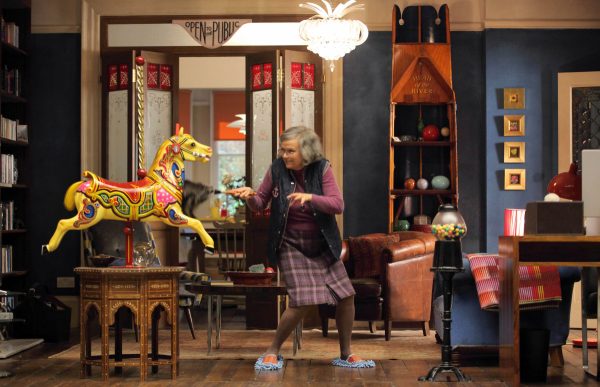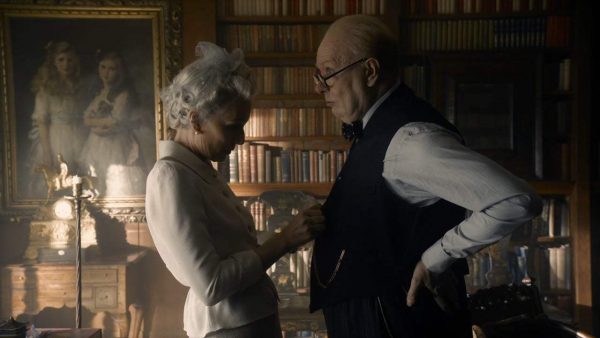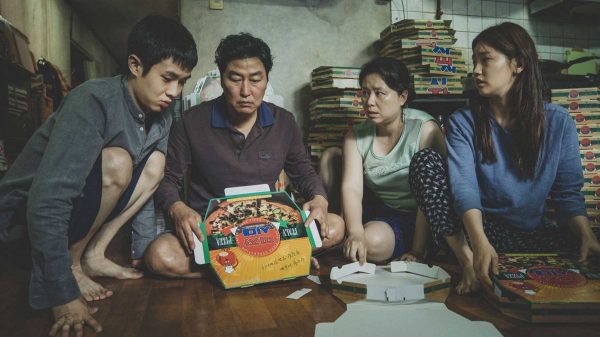by Dr Jane Barnwell
Watch the ViewFinder BoB Playlist for this essay
Introduction
The book I am writing explores the creation of the home on screen from the perspective of the production designer using in depth case studies with designers.
The case studies use a methodology developed for the analysis of production design called Visual Concept Analysis. The approach works through the five key ways a script is visualised by a production designer: 1) Space, 2) In and out, 3) Light, 4) Colour and 5) Set decoration. The case studies illustrate how decisions about the five elements are linked and return to the logic of the central visual concept driving the design.
Visual Concept Analysis builds on mise-en-scène theory in that it textually analyses the image but differs in that it identifies key areas that the production designer is responsible for and separates these out for further scrutiny. It is distinct in that it uses the five tools of space, in and out, light, colour and set decoration in order to comprehend the practical and conceptual solutions the production designer has employed to design problems posed by the script.
The approach is based on a dataset of interviews with leading contemporary production designers. Methodologically stemming from the creative process, beginning with the professional practices of production designers in visualising a script whereas other critical literature tends to start with the finished product and use film theory subsequently to form an understanding/analysis of the work.
The production designer is the person responsible for the overall look of a film, working in close collaboration with the director, cinematographer and other heads of department. They create the environment and visual style for the story to take place in. As head of the art department they oversee the realisation of their designs creating real and imagined worlds for the screen.

Paddington, 2014
The chapters in the book draw widely upon the production designer’s professional perspective and particular creative point of view, elaborating and expanding on themes of authorship, visibility, authenticity, acknowledgment, professional practice and codes of realism and visual storytelling. The success of the production designer is often tied to ideas around invisible design – environments that appear plausible and do not draw attention to their artificiality. The production designer is often key in the creation of the visual story as it appears on the screen and one of the aims of my writing is to render them visible in our reading of those images.
I explore the design of the home in film and television, considering spaces that have successfully impacted on popular consciousness. Whether it is the nurturing warmth of the Browns’ home in Paddington, the ambiguous boundaries of secret service agent homes in Tinker Tailor Soldier, Spy or the liminal space occupied by singleton Bridget Jones, the domestic interior has played a key role.
My Research
‘There is something about the medium of film that enables it to implant images in the mind that are more real than the real world; to stage-manage our perception of the facts of everyday life. Southern plantation houses look like Tara; airports look like the last scene in Casablanca; motels look like the Bates motel.’ (Sylvester, David 2000)
How are these film worlds constructed? As audience members, we often forget that the spaces we see on screen are mostly an illusion, created for the purpose of serving the narrative. Behind the scenes is the production designer, in charge of imagining and creating this fictional universe with the help of a large team of draftsmen, carpenters, painters and graphic designers.
The aim of my research has been to establish a new approach to understanding production design, drawing upon in depth and sustained research into their practice and contribution. Through production design interviews carried out since 2000, my research illustrates the fundamental contribution of the designer. Although each designer embodies an individual approach to their craft, they follow a similar creative process, seeking a visual concept and finding ways to visualise it on screen. Their responses to the script will vary enormously depending on their background and influences.
Initially the study sample for the interviews was chosen in relation to the designers I had access to, thus the majority belong to British cinema between the years 1970-2020. More recent research broadens the study to US, Australian and Korean designers. The work spans popular and cult films such as Caravaggio (1986), Trainspotting (1996) and My Beautiful Laundrette (1985) across genres from art house independent cinema to mainstream romantic comedies such as Notting Hill (1999), About A Boy (2002) and Bridget Jones Diary (2001).

Bridget Jones's Diary, 2001
The case studies of designers Christopher Hobbs, Stuart Craig and Peter Lamont exemplify the tension that exists in any project between realism and expressionism. Whereby Peter Lamont aligns his work with realism, Craig strives for what he terms ‘poetic truth’ and Hobbs wishes to create emotional authenticity.
Within the conversations the points that re-occurred began to form a narrative, a shared language voicing the mutual concerns of designers, which revolved around what I identified as five key strands that have provided the core elements of my model. The results illustrate a new perspective with which to appreciate the conceptual nature of the designer’s work and make visible their creative presence. My research frames the notion of the home in particular and its importance in the design and subsequent visual storytelling for the screen.
The Home
Myths have been cultivated around the home as a safe and secure structure embodying traditional family values. Signalling a yearning for community and something that never truly existed, the mythical place called home is constructed for audiences on the screen (Bronfen, 2001, 50). Screen homes can appear as familiar as our own, especially those we return to regularly in the form of series. In these recognisable spaces, we are reassured by the familiarity, continuing plot lines and a set of characters we know and love. A sense of belonging also comes with the knowledge of genre expectations, character, and setting. We feel at home in the constructed world around us. These ideas can also be fruitfully subverted where the home is used to trap characters and function as a site of anxiety and disturbance, in the tradition of gothic literature and appropriated by filmmakers such as Hitchcock who was fascinated by the domestic space as a place of secrets and concealment. (Jacobs 2013: 33)
A number of theorists have projected spiritual space onto that of the home (Bachelard, 1994; Freud, 1953; Jung, 2012; Pile, 1996; Vidler, 1992). Whereby the domestic interior can be seen as a symbolic reflection of the human interior landscape. This resonance of the home in the personal and collective consciousness is explored and cultivated in the creation of screen homes. Screen space plays on the ways attics, basements and bedrooms hold different roles in our daily imaginary lives. The physical realm and abstract notions of space cannot be disconnected from our memories, dreams, fears, desires and everyday existence (Jacobs, 2013, 10). Freud’s theory of the uncanny relates closely to a discussion of a home that is familiar yet ‘un-homely’ (unheimlich). The uncanny home is a familiar aspect of the gothic and horror genres, where the sense of unease created in the domestic environment can be so integral to the narrative that it becomes a character in itself (1). For Freud, this combination of strangeness and familiarity resonates most strongly in relation to the mother’s body, the original home, which is a ‘forgotten place’ (through repression of the trauma of childbirth) but still familiar. Such connections point to the importance of the relative locations of rooms within houses in the construction of meanings and pleasures, for example the uterine connotations of dark enclosed spaces (Andrews, Hockenhull and Pheasant-Kelly, 2016, 8).
The private environment of the home is often a key to understanding character, where ideas can be distilled and accentuated. Personal space can mirror a character’s psychology, the interior décor reflecting interior landscape and layers of backstory. Character and story are closely entwined in the domestic setting, which is often the place that undergoes transformation to signify changes taking place in the narrative arc.
Describing the importance of ‘getting back home’ in relation to setting, production designer Richard Sylbert argues, ‘That’s the way Mozart structured music. You always went back home […] now home and getting back home are very serious ideas […] it satisfies the mind and closes the circle’ (1989, 22)

Paddington 2, 2017
This is a recurring theme in writing about the design of the home, for example one of the chapters in my book explores the role of the home and the prison environment in the representation of character and narrative in the film Paddington 2 (2017). The Brown’s home, Paddington’s family home, is established as a warm and welcoming environment, which Paddington is forcibly removed from when he is wrongly sent to prison. On arrival, the prison appears to be a classic harsh and hostile place of incarceration where Paddington is intimidated and alone. However, Paddington’s presence is slowly seen to transform the place into a warm and inviting world full of friendship and hope. The prison is a key setting in the film, which playfully stitches together popular notions of the real and imagined prison and turns into a community where friendship, food and flowers blossom. It effectively forms a transition space linking Paddington’s journey away from home and back again. The design is crucial in conveying key themes in the script that reflect Paddington’s character and the positive impact he has on people’s lives. The changes we see taking place in the prison are metaphors that convey the visual concept at the heart of the film design.
Paddington eventually closes the narrative circle by returning home. Order appears to have been restored as thespian antagonist, Phoenix Buchanan (Hugh Grant) is sent to prison in his place. However, not only has the prison remained a cosy reflection of Paddington’s character it now incorporates the high camp theatricality of its new inhabitant, complete with a closing musical number that sees Buchanan singing and performing to rapturous applause from the inmates. The design functions to reflect these changes physically while also visualising the underpinning concepts at work in the narrative.
The notion of home is particularly poignant in a wider sense, as Paddington can be understood as an outsider story, having migrated from Peru and made London his home, while also being an anthropomorphic bear interacting with humans. The film contains messages of tolerance toward difference and diversity, particularly in that Paddington’s marginal status is foregrounded and his differences identified as strengths through the course of the narrative.

Darkest Hour, 2017
Similarly in the film Darkest Hour (2017) the home is recruited to communicate wider notions around nation, belonging and democracy. Production designer Sarah Greenwood used the real exterior of 10 Downing Street combined with built interiors to convey the sense of struggle and lack of clarity during the tense period in British history portrayed in the film. Downing Street does not stand apart from the other settings in the film blending as it does with the dreary lacklustre looking London of the period. Functional stripped back to the bone interiors in need of repair hint at failure. In spite of the uninspiring appearance and peeling paintwork the sense that we are all in it together is echoed repeatedly in the design.
The domestic interior of Winston Churchill blends with both the public government interiors and the other private homes of individuals. As such it functions as an in between space where the joining of public and private worlds indicates a democratic flow in spite of existing hierarchical structures. This stands in deliberate contrast to the fascist ideology that is being fought against. A maze ultimately leads us to the democratic space at the centre of wartime Britain and reflects the strong sense of unity at the core of the story.
Conversely, in the film Parasite (2019), the home is designed to convey the divisions in South Korean society based on the visual concept of vertical hierarchy. The home is central to the real and metaphorical struggle over belonging in a capitalist society that no longer values humanity. The two key homes in the film are metaphors for the characters’ situation but also the wider social collapse of a hierarchical system that fails to work for anyone. The production design visually displays and examines the gap between those with economic power and those without.

Parasite, 2019
In the Netflix series Stranger Things (2016-2020) the Byers home is designed as a transition space physically and metaphorically, situated on the edge of the woods on the outskirts of town, a liminal place between the town, the forest and the ‘Upside Down’. It is in this house that traditional boundaries are broken and temporary ones created, rupturing and subverting conventional entrance and exit points.
In the film Tinker Tailor Soldier, Spy (2011) the home is more ambiguous, with the issue of visibility being key and the lack of clear division between interior and exterior combining to create a provocative screen image. The boundaries between public and private space are designed to accentuate themes around espionage.
‘John Hurt said that he didn’t realise how mad Control was until he saw where he lived.’ (Maria Djurkovic, 2015)
The notion of home and returning home is fundamental in Tinker, enhancing character and story through the visual concept of the design. Home in this instance incorporates the additional nuance of country and empire to a certain extent folding in nostalgia for a lost myth of Englishness and the cultural imperialism of the English gentleman.
‘Every space that any character inhabits obviously has to be full of clues for that character. Control’s crazy messy flat gives us plenty of clues for his state of mind. Dressing any set is hugely important to me, I am very involved in it, it is crucial to the story telling.’ (Djurkovic, 2015)
Giving clues to character as Djurkovic says becomes even more relevant when spies are central to the story; what is revealed and concealed takes on greater significance.
Whether used as a transition space, an ideal, a catalyst for change or a place to return to the case studies in the book examine the pivotal role of the production designer in creating screen homes.
(1) According to Bart Mills, "The set is like a third actor" (1982, 40).
About the Author
Dr. Jane Barnwell is Senior Lecturer in Moving Image at the University of Westminster. Home: The Domestic Interior on Screen is due to be published in 2021 by Palgrave Macmillan.
Previous Publications
Production Design for Screen: Visual Storytelling in Film & TV
https://www.bloomsbury.com/uk/production-design-for-screen-9781472580672
The Fundamentals of Filmmaking
https://www.bloomsbury.com/uk/the-fundamentals-of-film-making-9782940373192/
Production Design: Architects of The Screen
https://www.amazon.co.uk/Production-Design-Architects-Screen-Wallflower/dp/1903364558
References
Andrews, Eleanor Hockenhull, Stella and Pheasant-Kelly,Fran, 2017. Spaces of the Cinematic Home. Behind The Screen Door. Routledge: Oxfordshire
Bachelard, Gaston, 1994. The Poetics of Space, Beacon Press: Boston
Bronfen, Elisabeth, 2001. Home in Hollywood. The Imaginary Geography of Cinema. Columbia University Press: New York.
Djurkovic, Maria. 2015. Author interview
Freud, Sigmund, 2003. ‘The Uncanny’ 1919, Penguin: London
Greenwood, Sarah. 2018. Author interview
Jacobs, Steven, 2013. The Wrong House: The Architecture of Alfred Hitchcock. Rotterdam: NAI Publishers
Sylbert, Richard, 1989. “Production Designer is his title. Creating realities is his job.” American Film 15, no. 3: 22-26
Sylvester, David, 2000. Moonraker, Strangelove and Other Celluloid Dreams: The Visionary Art of Ken Adam. London: Serpentine Gallery.